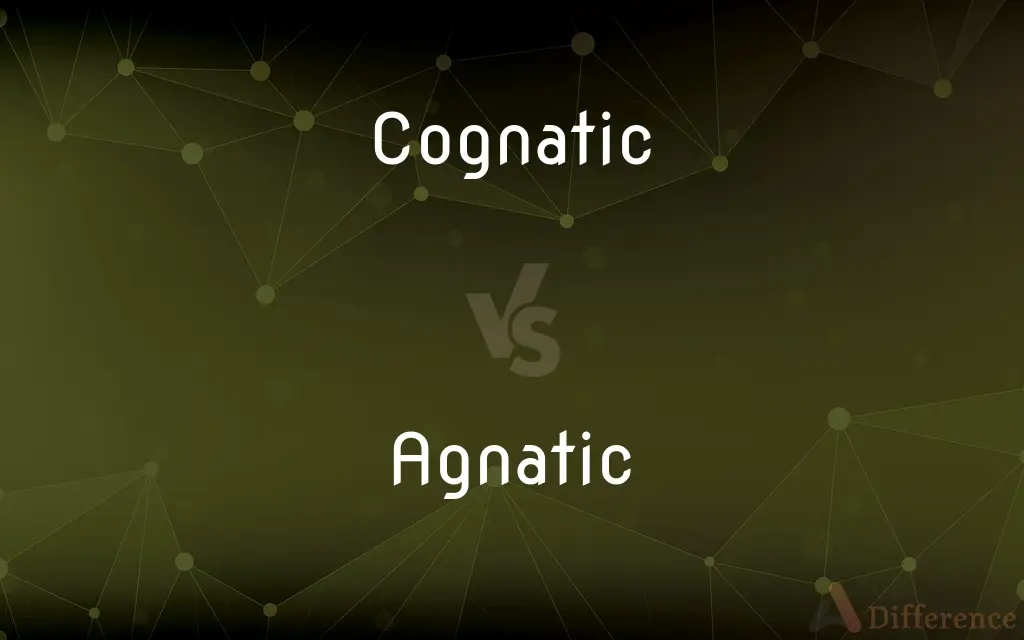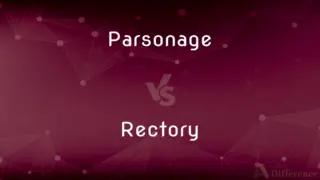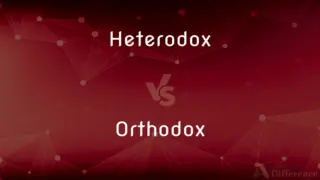Cognatic vs. Agnatic — What's the Difference?
By Maham Liaqat & Fiza Rafique — Updated on March 27, 2024
Cognatic descent includes both male and female lineage for inheritance and succession, while agnatic descent strictly follows the male line.

Difference Between Cognatic and Agnatic
Table of Contents
ADVERTISEMENT
Key Differences
Cognatic descent, also known as bilateral descent, recognizes both the mother's and father's lines as equally important in determining kinship, inheritance, and succession rights. This system allows for a more inclusive approach to lineage, acknowledging the contributions and roles of both parents in the continuation of a family's heritage. On the other hand, agnatic descent, or patrilineal descent, traces lineage and inheritance through the male line exclusively, often sidelining the maternal contributions and limiting succession and inheritance rights to male descendants.
In societies practicing cognatic descent, children are considered part of both parents' families, allowing them to inherit property, titles, and rights from both sides. This system can lead to a more distributed and equitable sharing of family wealth and responsibilities among all descendants, regardless of gender. Conversely, agnatic descent emphasizes the importance of the male line in preserving family identity and heritage, often leading to a concentration of wealth, power, and responsibilities within the male lineage, sometimes at the expense of female relatives.
Cognatic systems are found in various cultures and legal systems around the world, reflecting a more gender-neutral approach to lineage and inheritance. These systems can support more egalitarian societal structures, where women's roles and contributions are valued similarly to men's. Agnatic systems, however, are prevalent in societies with strong patriarchal traditions, where preserving the family name, estate, and power through the male line is considered crucial for social and familial stability.
The choice between cognatic and agnatic descent has significant implications for family dynamics, inheritance laws, and the status of women in society. Cognatic descent allows for more flexibility and inclusivity, potentially leading to more balanced and equitable family and societal structures. Agnatic descent, while promoting continuity and stability within the male line, can result in inequalities and exclusion based on gender, affecting the rights and statuses of female family members.
Both cognatic and agnatic descent systems have their historical and cultural justifications, shaped by the needs, values, and traditions of their societies. While cognatic descent reflects a move towards more inclusive and equitable practices, agnatic descent remains relevant in contexts where lineage and inheritance through the male line are prioritized for cultural, political, or economic reasons.
ADVERTISEMENT
Comparison Chart
Lineage Tracing
Both male and female lines.
Strictly male line.
Inheritance Rights
Inherited from both parents' families.
Inherited through the male line only.
Societal Structure
Supports more egalitarian structures.
Often supports patriarchal traditions.
Family Dynamics
Equitable sharing among all descendants.
Concentration of wealth in male descendants.
Cultural Prevalence
Found in various cultures, more gender-neutral.
Prevalent in patriarchal societies.
Compare with Definitions
Cognatic
Gender-Neutral Inheritance.
The cognatic system allowed both sons and daughters to inherit land and titles.
Agnatic
Patrilineal Descent.
In agnatic descent, the family name and estate are passed down through the male line.
Cognatic
Bilateral Descent.
Through cognatic descent, the property was equally inherited from both grandparents.
Agnatic
Male-Only Inheritance.
The agnatic system restricts inheritance of the throne to male descendants.
Cognatic
Egalitarian Family Structure.
Cognatic descent fosters a more balanced distribution of familial responsibilities.
Agnatic
Strengthens Patriarchal Traditions.
Agnatic descent reinforces male authority and leadership in the family.
Cognatic
Supports Matrilineal and Patrilineal Ties.
Recognizing ties through both parents strengthens extended family connections.
Agnatic
Concentrates Wealth and Power.
Through agnatic descent, assets remain within the male side of the family.
Cognatic
Reflects Modern Legal Systems.
Contemporary inheritance laws often embody cognatic principles, ensuring equal rights.
Agnatic
Cultural and Historical Significance.
Historical dynasties often relied on agnatic principles to preserve lineage.
Cognatic
Of or relating to a mode of descent calculated from an ancestor or ancestress through any combination of male and female links, or a system of bilateral kinship where relations are traced through both father and mother.
Agnatic
Related on or descended from the father's or male side.
Agnatic
Coming from a common source; akin.
Agnatic
A relative on the father's or male side only.
Agnatic
Pertaining to descent by the male line of ancestors.
Agnatic
Related on the father's side;
A paternal aunt
Common Curiosities
What is cognatic descent?
Cognatic descent is a kinship system where lineage, inheritance, and succession rights are traced through both male and female ancestors equally.
Which societies typically use cognatic descent?
Societies that emphasize gender equality and have more egalitarian views on inheritance and family structure tend to use cognatic descent.
How does agnatic descent differ from cognatic descent?
Agnatic descent traces lineage and inheritance exclusively through the male line, excluding female lineages from inheritance and succession rights.
Why do some societies prefer agnatic descent?
Societies with strong patriarchal values or those that prioritize the continuity of family name and estate through males often prefer agnatic descent.
Can a family choose between cognatic and agnatic descent?
Depending on the legal system and cultural practices, families may have some degree of choice in adopting cognatic or agnatic principles for inheritance.
What are the implications of cognatic descent for women?
Cognatic descent can lead to more equitable treatment of women in terms of inheritance and recognition within the family and society.
How does agnatic descent impact family wealth distribution?
Agnatic descent tends to concentrate wealth and power within the male members of the family, potentially leading to inequalities.
What challenges might arise from agnatic descent?
Challenges include potential disputes over inheritance, unequal treatment of female family members, and the concentration of family wealth.
Can a society transition from agnatic to cognatic descent?
Yes, societies can transition from agnatic to cognatic descent through legal reforms and changes in cultural attitudes towards gender equality.
How does cognatic descent affect extended family relationships?
It tends to strengthen connections with both maternal and paternal relatives, broadening the sense of family and support networks.
How do inheritance laws adapt to cognatic principles?
Inheritance laws adapting to cognatic principles ensure equal rights to property and titles for both male and female descendants.
Is cognatic descent becoming more common?
With shifts towards gender equality and changes in legal frameworks, cognatic descent is becoming more common and accepted globally.
Are there any religious influences on descent systems?
Yes, religious beliefs and teachings can significantly influence societal preferences for cognatic or agnatic descent systems.
Can agnatic and cognatic principles coexist in a society?
While fundamentally different, hybrid systems incorporating elements of both principles can exist, depending on legal, cultural, and familial contexts.
What role do legal systems play in enforcing descent systems?
Legal systems play a crucial role in defining and enforcing rules around descent, inheritance, and family rights, often reflecting societal values and changes.
Share Your Discovery

Previous Comparison
Parsonage vs. Rectory
Next Comparison
Heterodox vs. OrthodoxAuthor Spotlight
Written by
Maham LiaqatCo-written by
Fiza RafiqueFiza Rafique is a skilled content writer at AskDifference.com, where she meticulously refines and enhances written pieces. Drawing from her vast editorial expertise, Fiza ensures clarity, accuracy, and precision in every article. Passionate about language, she continually seeks to elevate the quality of content for readers worldwide.















































